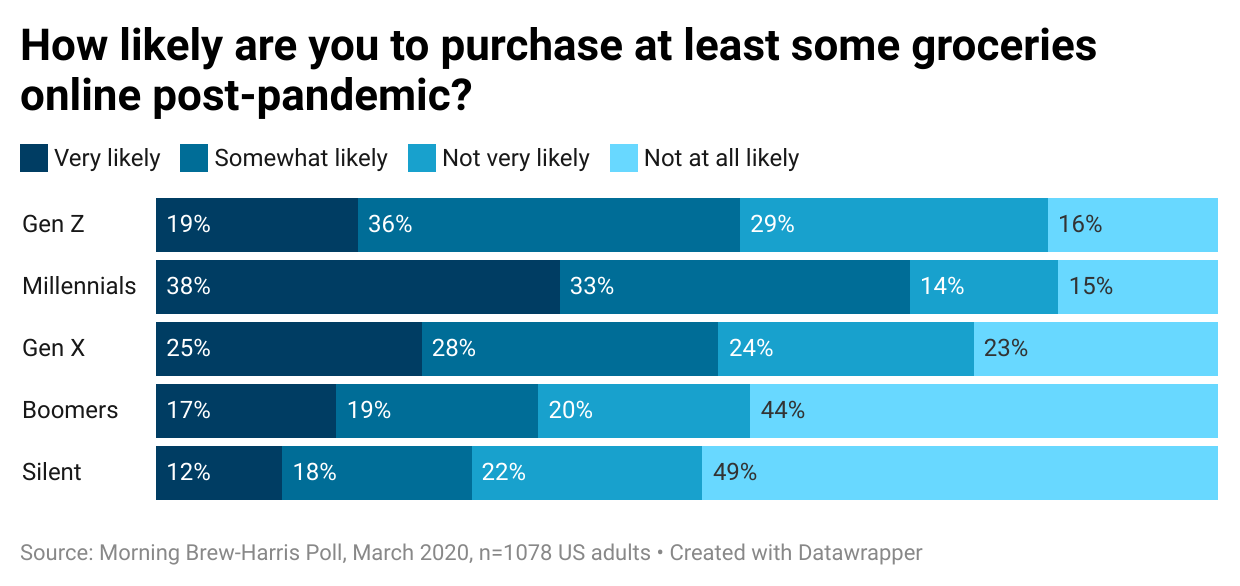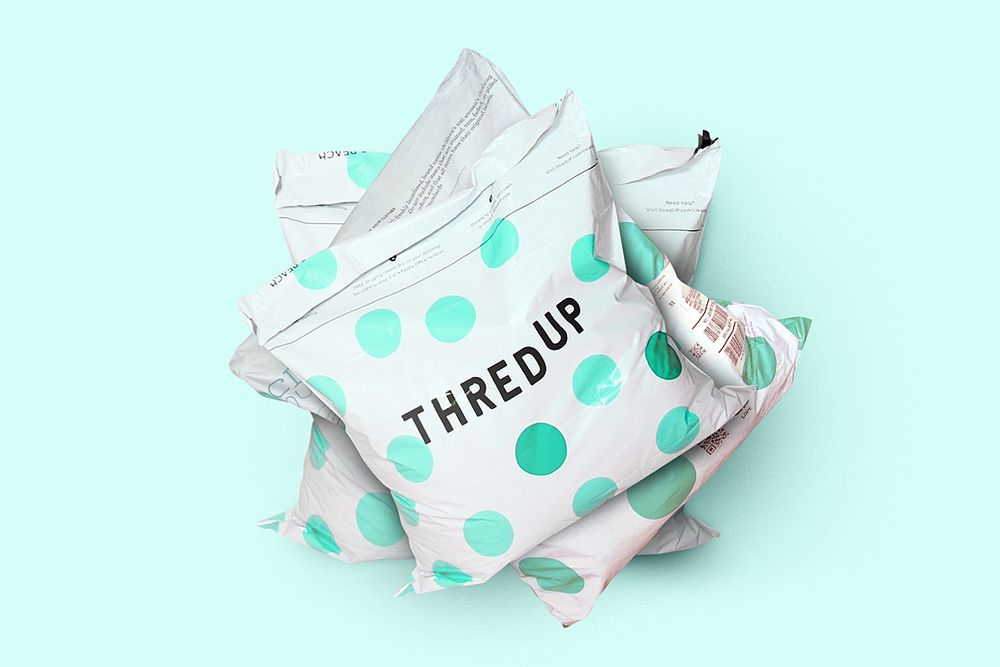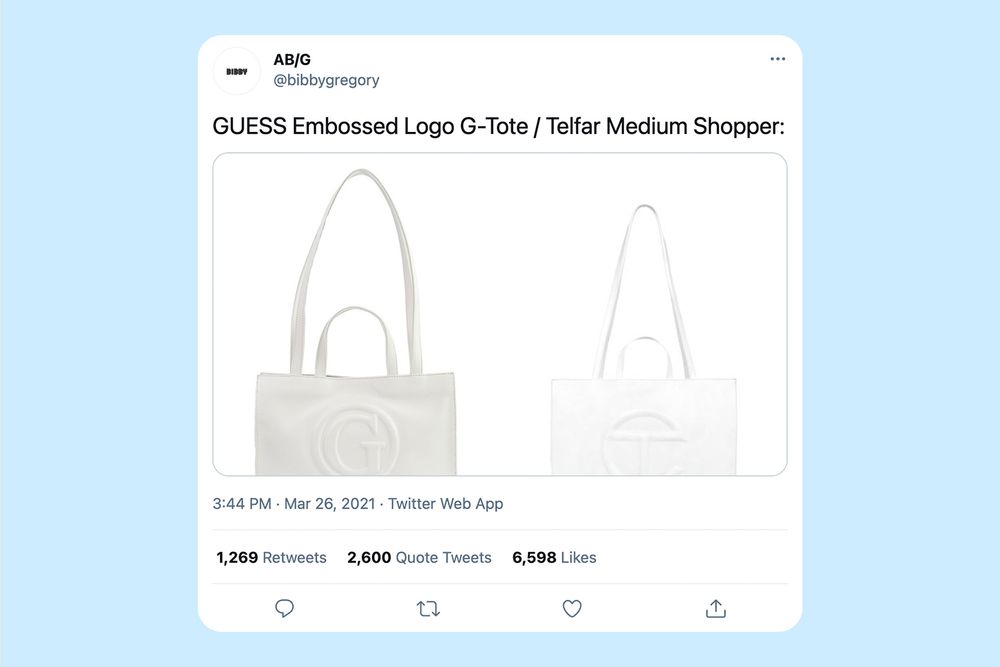|
Good afternoon. Unlike our friends at Emerging Tech Brew, we don't have AI that predicts reader interests. So to make Retail Brew 100% tailored to your needs, we’re going old school with a new reader survey. You can fill it out right here.
In today’s edition:
- Shifting grocery habits
- Q&A with ThredUp’s CEO
- Guess pulls Telfar lookalikes
— Halie LeSavage, Katishi Maake
|
|
|
Covid-19 jumpstarted a retail phenomenon more inevitable than Thanos: online grocery shopping. Retail Brew’s exclusive Harris Poll survey of 1,078 US adults suggests the ramifications will be long-lasting, even if some consumers still prefer to explore the aisles.
- More than half (52%) of Americans say they’ll purchase some of their groceries online post-pandemic, while 48% are not very likely to.
- 71% of millennials and 55% of Gen Zers are somewhat likely to order groceries online, compared to 53% of Gen Xers and 36% of baby boomers.
Reality check: Last Friday, we reported survey results from the same poll, which found a plurality of Americans want to primarily shop in-store once restrictions are lifted, though online grocery shopping will remain much more common than before.

Dan McCarthy
The cream rises to the top
So how big was the shift to digital? According to our survey, 22% of shoppers said they had bought groceries online before March 2020, while 37% do so now. But 28% say they rarely or never order groceries online, versus 15% who don’t shop in person.
Another measure: E-comm grocery sales increased 54% to $95.82 billion in 2020, but that’s still just 7.4% of the total US grocery market, according to eMarketer. They expect online grocery sales to hit $112.9 billion by year’s end.
Industry experts believe big name grocers will dominate this relatively small—but growing—segment via costly new investments, making it harder for smaller grocers to compete. Two examples:
- Walmart overtook Harris Teeter as Charlotte, NC’s predominant grocer in 2019, and the pandemic widened the gap due to e-comm capabilities. Walmart held a 21.1% market share last year, compared to Harris Teeter’s 16.5%.
- The US’s third largest grocer, Albertsons, reported e-comm gains of at least 200% in 2020. It’s now expecting e-comm to account for as much as 20% of total sales, and is building several new micro fulfillment centers (MFCs). MFCs from Takeoff Technologies, which powers Albertsons’s two existing MFCs, cost around $3 million for a 10,000-square-foot system.
Zoom out: The big/little divide may force smaller and independent chains to start or continue using less expensive digital solutions like Instacart-esque partnerships and self checkout services. Smaller grocers can also lean into their strength: offering competitive prices and customized inventory that fit their communities’ needs.
|
|

Francis Scialabba
|
ThredUp, the resale site where almost any castoffs can find a new closet, raised $168 million in its IPO last week.
CEO James Reinhart gave Retail Brew firsthand insights into the secondhand marketplace’s next steps as a public company. Here are the highlights.
Yes to retail partners. ThredUp has partnered with 21 brands for online and IRL resale partnerships, and more are en route.
- Reinhart said secondhand is growing so fast—25x regular apparel sales year over year—that ThredUp isn’t fazed by brands’ in-house resale shops.
- But with ten years of reverse logistics tech development on its side, ThredUp expects to make significant $$$ handling resale ops for brands anyway.
Yes to automation. Reinhart told us that 100% of ThredUp’s inventory will be held in semi-automated facilities by the end of 2021. Automation will speed up processing capacity, alleviating the listing delays that hit some sellers ( ) during the pandemic’s resale spike. ) during the pandemic’s resale spike.
No to new categories—yet. While peers like Poshmark expand into home and pet goods, “we think the women's market is by far the biggest opportunity,” Reinhart said. “I think anything we do that takes our eyes off the women's market is a distraction.”
- Still, Reinhart added that ThredUp will “start experimenting” with new categories in 2022.
|
|
SPONSORED BY MARKETERHIRE
|

|
They have the marketing skills to bring your business better results. So instead of just getting by with your marketing initiatives, start getting ahead with the marketing talent of MarketerHire.
They make it easy to hire great marketers. With pre-vetted talent and expert hand-matching, you can add a proven marketer to your team in less than a week.
And if that sounds too good to be true, we’ve got the stats to back it up. Take a peek at some of the results companies have seen since turning to MarketerHire:
- Superkin maternity wear looked to MarketerHire's network for SEO help and saw a 106% increase in organic traffic.
- Bottlecode men's skincare experienced 20% order growth month-over-month for 5 straight months.
With MarketerHire, you’re getting the best of the biz—with talent from global brands and hot startups alike.
Get a free consultation with MarketerHire today.
|
|

@bibbygregory
|
Another big retailer crossed the line from flattery into forgery last week. This time, the copied label finished on top.
Same story: Social media users noticed that a logo-embossed Guess bag looked familiar—too familiar, to fans of Telfar and its continually sold-out tote bags. Within hours, an online chorus called for Guess to discontinue its Telfar lookalike.
Twist ending: Signal Brands, Guess’s handbag licensee, read its mentions.
Signal all but copped to copying in a statement shared by Complex: “Signal Brands does not wish to create any impediments to Telfar Global’s success and, as such, has independently decided to stop selling the G-logo totes.”
- The copycatchalls will be pulled from retailers including Macy’s, Hudson’s Bay, and Dillard’s.
Why it matters: Small brands with breakout products are often imitated but rarely knock out knockoffs without legal action.
- But the strength of Telfar’s fanbase—fueled by its positioning as an “accessible luxury” player—guaranteed a swift response.
- The Telfar team told the NYT they didn’t perceive the Guess bag as a threat, because Telfar’s community can’t be replicated by corporate.
Meanwhile, Telfar is busy prepping for tomorrow’s Bag Security Program relaunch, an on-demand ordering event for its hero item. 2020’s first rendition generated 10x more sales in one day than the brand recorded in all of 2019.
|
|
-
H&M stores in China are closing amid conflicts over Xinjiang cotton.
-
Google wants to position its shopping tools as the anti-Amazon, the NYT reports.
-
Herman Miller opened a flagship store for its eight subsidiary brands.
-
Ever Given watch: Ikea has ~110 cargo containers on the newly unstuck ship.
|
|
|
We at Retail Brew strive to serve you the best retail recaps and reporting in every edition. But like our friends at Lowe’s, we can never stop improving.
Where we’re starting: We’re running a reader survey this month, and we’d love your input. By filling out our quick survey, you’ll help us better ID 1) your needs as busy retail professionals and 2) how we can shape Retail Brew just for you.
Ready to chime in? We’re excited to get to know you better *and* hear your feedback. Click here to take the survey.
|
|

|
Give your brick-and-mortar store a modern edge. Endear is the only tool you need for retail clienteling today and in the future. With a retail-first CRM, personalized messaging, and sales tracking all within one platform, Endear helps your team drive conversations—and conversions—both online and in-store. Users typically see their first sale from the app within the first week. Try Endear for free for 14 days right here.
|
|
|
Nike is cutting ties with more wholesale partners, including Urban Outfitters, Macy’s, DSW, and Dunham’s. The company is zeroing in on its DTC business, and leaving these big box retailers wondering: What can replace the most popular athletic brand in the world?
- Major sports brands like Adidas and Under Armour also want to cut back on wholesale, so they’re probably not candidates for this role.
This week’s question: Do you believe retailers will be able to find a single brand to replace Nike? Let us know here.
Last week’s question: We asked, “What’s the best strategy for retailers to get around or make up for supply chain shortcomings?” (Looking at you, Ever Given.) Nearly 37% said increased air freighting, while about 35% believe enhancing micro fulfillment is the answer.
|
|
|
March Madness is in full swing, minus the crowded sports bars and wing specials. Enter: a new class of retail innovators dedicated to *checks notes* chicken R&D?
- Why Applebee’s and Chili’s are spreading their wing menus to virtual-only brands. (WSJ)
- Inside the “Tesla of chicken,” an alt-meat nugget startup that chose ghost kitchens before traditional retail. (Fast Company)
|
|
|
Catch up on the Retail Brew stories you may have missed.
|
|
|
Written by
Halie LeSavage and Katishi Maake
Was this email forwarded to you? Sign up here.
|
ADVERTISE // CAREERS // SHOP
Update your email preferences or unsubscribe here.
View our privacy policy here.
Copyright © 2021 Morning Brew. All rights reserved.
22 W 19th St, 8th Floor, New York, NY 10011
|
|









